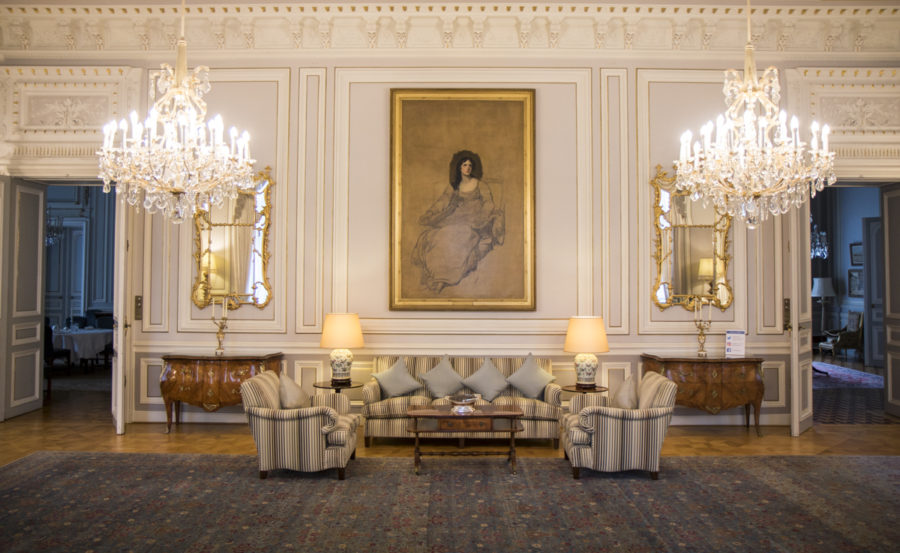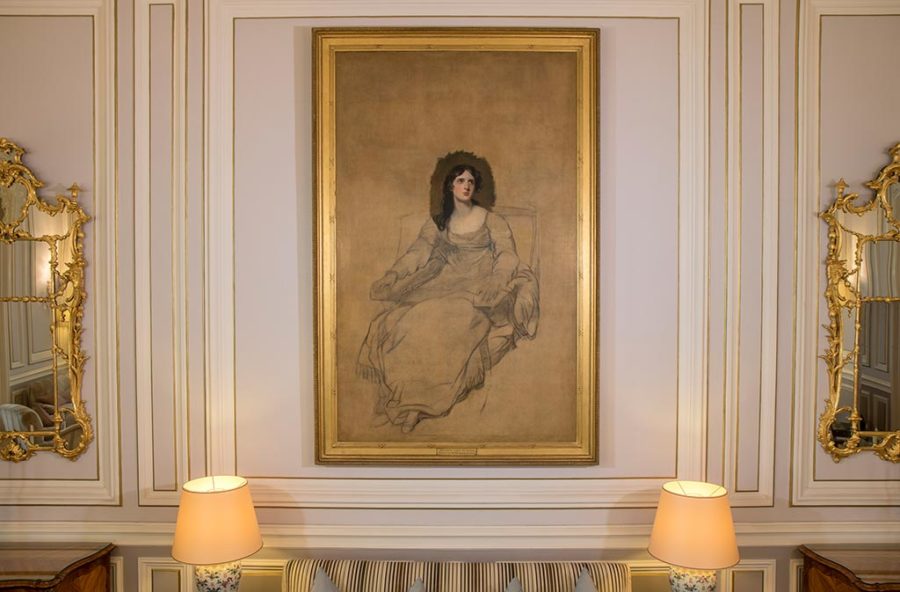15th November 2017 Vienna, Austria
Lady Nugent: portrait of purity

One of the most beautiful, and enigmatic, artworks in the British Embassy in Vienna is Anne Lucy Grenville, Lady Nugent, by the renowned portrait painter Sir Thomas Lawrence. It dates from 1813, around the time that Anne Lucy Poulett (her maiden name), aged 23, married George Nugent Grenville, second Baron Nugent of Carlanstown.
The portrait is unfinished, with only what the Exeter and Plymouth Gazette described in 1830 as the “head and bust” complete. The rest of the scene, showing Lady Nugent sitting in a throne-like chair, survives only as a chalk sketch.

Thomas Lawrence, Anne Lucy Grenville, Lady Nugent (nee Poulett, 1790-1848), oil painting, on loan to the Government Art Collection from a private collection
Several details of the work are intriguing.
Why is the painting unfinished? According to the Exeter and Plymouth Gazette: The portrait is a head merely, in medallion; but the original picture was intended to be a whole length, the size of life. The head and bust had been long finished, but the completion of the lower portion of the work was (as usual with Sir Thomas) delayed from time to time, till the noble husband of the lady grew impatient. At length, Sir Thomas one day declared to Lord Nugent that the picture should positively be finished in the day after the opening of the exhibition of that year: and he added that if it was not finished by that time he would consent that his Lordship should take it away unfinished, and he would not take anything for it. Lord Nugent watched for the promised day with some anxiety – on its arrival he went to the house of Sir Thomas, and not finding him at home, penetrated into his painting room, where he found the picture, untouched since the last promise made to him – brought it away with him in his carriage – and in the same state it remains to this day – the whole of the figure below the bust being drawn in white.
This account seems to suggest that Lord Nugent never paid for the painting.
A second question is why Anne Lucy is wearing such a curious expression: imploring, yet full of character. The work was intended to show Lady Nugent in the guise of the female role (called simply “the Lady”) in Milton’s masque Comus, dating from 1634. A masque was a kind of simple play performed at a noble court – a well-known example is the play-within-a-play Pyramus and Thisbe in Shakespeare’s A Midsummer Night’s Dream.
In Milton’s masque the eponymous Comus, the ancient Greek god of festivity, revels and nocturnal dalliances, captures “the Lady” in a forest and binds her helplessly in an enchanted chair. He then urges her to “not be coy” and to drink from his magical cup, representing sexual pleasure and intemperance. She, however, refuses, arguing for the virtues of temperance and chastity. She is later rescued, unharmed.
This tells us that a) the portrait is designed to emphasise the chastity and virtue of Lady Nugent at the time of her marriage; b) we are witnessing a debate on a key issue of classical and modern thought: whether our desires are natural and should be indulged, or whether self-control is intrinsically more virtuous; and c) Lady Nugent (as “The Lady”) is depicted as bound helplessly – but fiercely resisting – to the chair, adding a whole new meaning to the portrait. Fascinating stuff.
Although Sir Thomas Lawrence never completed the painting of Lady Nugent, he did complete a portrait of her husband at around the same time (at the link). I was struck seeing this for the first time to imagine how the portrait of Anne Lucy might have turned out if it had been completed. For example, in Milton’s Comus, while “the Lady” is restrained, she is tempted by an array of cuisine designed to arouse her appetites and desires. Might that delicious spread have appeared in the painting?
The portrait of Lord Nugent also surprised me by his youth: at 25, was only two years older than his wife. I realised I had assumed, because of the inequality between their paintings (his: completed; hers: unfinished) and her plaintive expression, that he was a much older man. Beware assumptions. I have not been able to find out much about the painting of Lord Nugent, which is in a private collection; but would be interested to know whether it, too, is allegorical and refers to his chastity and virtue (or any other classical allusion). Does anyone know?
Anne Lucy Grenville, Lady Nugent, never had children. She died aged 58 in the year of revolutions, 1848. When her husband died in 1850, the barony became extinct.
May I kindly ask you to get in touch with me, precisely concerning art….about your faible for Klimt, Schiele & Co.
Best regards
…no Instagram, no twitter account, just LinkedIn..